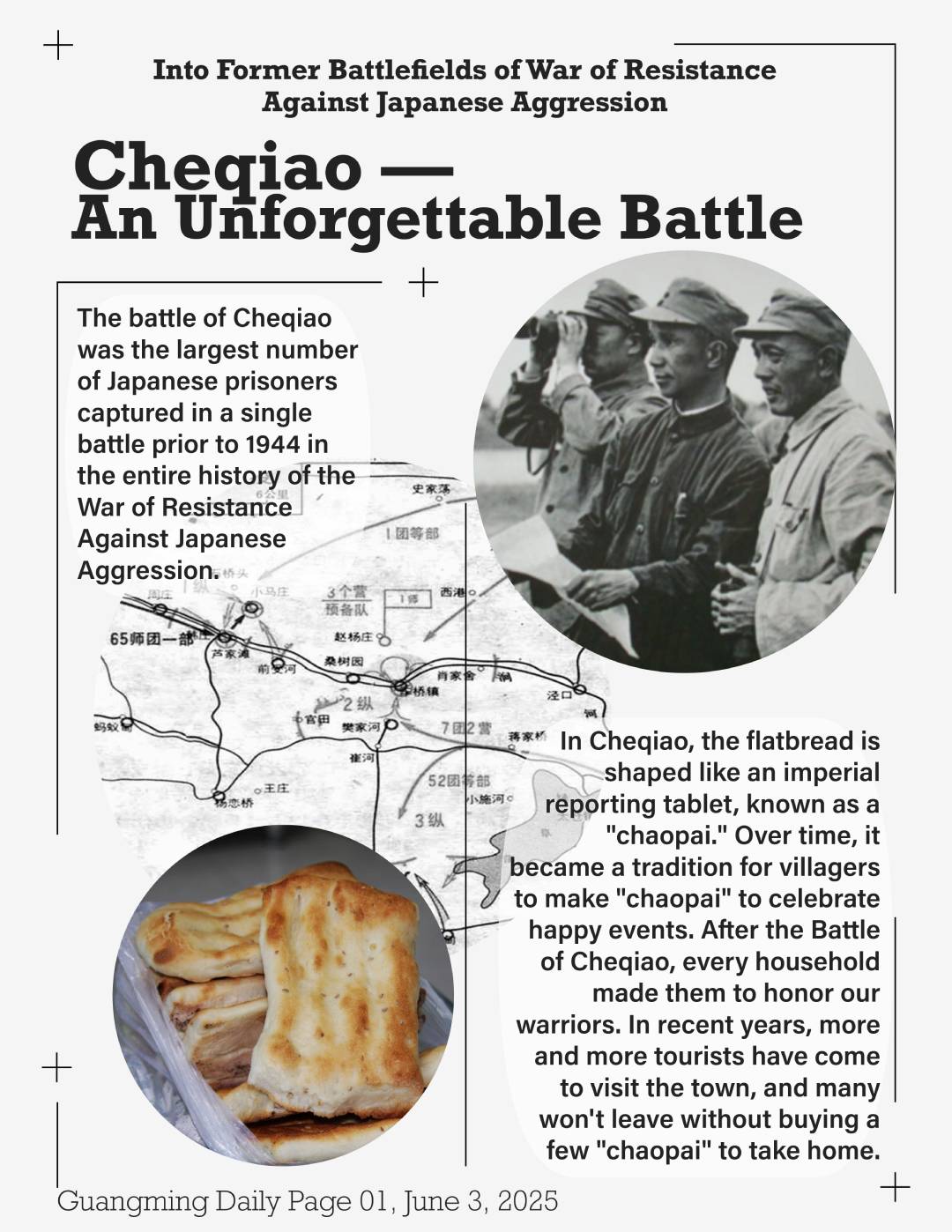


"Attack!" Su Yu's voice was low, but firm, as he pointed at the operations map.
His finger landed on two characters: "Cheqiao."
The Battle of Cheqiao would become one of the most meticulously planned operations of Su Yu's military career.
Cheqiao is now a town in Huai'an District, Huai'an City, Jiangsu Province. Located about 20 kilometers southeast of downtown Huai'an, it sits between Huai'an, Jinghe, Jingkou, and Caodian. It was named "Cheqiao" because five stone bridges span its waterways—together forming the shape of the traditional Chinese character for "chariot" (車).
On October 21, 1939, Japanese forces occupied Cheqiao, turning the town into a key stronghold for controlling southeastern Huai’an and northeastern Baoying. The Jianhe River, which runs through Cheqiao, marked the boundary between the Communist-led anti-Japanese base areas in northern and central Jiangsu. The capture of Cheqiao would enable the unification of four major base areas: Central Jiangsu, Northern Jiangsu, Huainan, and Huaibei—linking them into a contiguous anti-invasion rear area across central China.
Yet Su Yu was deeply troubled over how to attack Cheqiao.
After occupying the town, the Japanese forces had built a formidable line of defense: pillboxes, fortified walls, and a deep trench measuring over 5 meters. With heavy firepower deployed, they boasted that Cheqiao would become an "impregnable fortress of iron." To make matters worse, any sign of attack would instantly draw Japanese reinforcements from nearby strongholds—especially from Huaiyin and Huai'an, just a stone's throw away. Our attacking forces would risk being encircled from behind.
The New Fourth Army had never engaged in a major assault operation against a fortified position before.
Starting in April 1943, the name "Cheqiao" became etched in Su Yu's mind—along with the hand-drawn battle map that he would continue to revise and enrich with new ideas.
In June that year, Su Yu—then Commander of the New Fourth Army's 1st Division and concurrently Commander and Political Commissar of the Central Jiangsu Military Region—traveled to Huanghuatang in Xuyi County to attend a rectification meeting and report on his work. On the way, he deliberately detoured through Cheqiao, bringing along the chief of reconnaissance. They conducted thorough field investigations of enemy positions, terrain, roads, and local public sentiment. From this, a strategic plan to seize Cheqiao and repel enemy reinforcements began to take shape.
Never fight an unprepared battle—Su Yu believed in that principle deeply. He began drafting the operation with precision: The New Fourth Army would mobilize five regiments in three columns. Brigade Commander Tao Yong would lead the 2nd Column to launch the main assault on Cheqiao. Regiment Commander Liao Zhengguo would position the 1st Column in ambush near Lujia Beach, northwest of the town, to intercept reinforcements from Huaiyin and Huai'an. The 3rd Column would build defensive positions near Cuihe, south of Cheqiao, guarding against reinforcements from Caodian and Baoying. A reserve force would stand ready to plug any breaches.
By now, nearly a year had passed since Su Yu first cast his eyes on Cheqiao. Preparations had proceeded methodically: Secret embankments had been built along the Jianhe River to block enemy ships; Local villagers dismantled their own homes, laying doors and beams across small boats to form makeshift bridges so our light vessels could cross swiftly; All roads surrounding Cheqiao had been cut off, isolating the enemy.
At 1:50 a.m. on March 5, 1944, Tao Yong's unit—the spearhead of the assault—launched its surprise attack. Gunfire erupted like thunder, battle cries shattered the stillness. Our soldiers surged across the trench and over the fortified walls like a rising tide. Signal flares streaked across the night sky. In less than an hour, our forces had breached the ramparts, captured more than 10 enemy bunkers, seized control of every street, and encircled the Japanese and puppet troops entrenched in town.
Amid the fierce fighting, Chen Futian—a New Fourth Army soldier nicknamed the “Flying General”—climbed onto the roof of a bunker with a pickaxe strapped to his back. He smashed it open and tossed in bundles of grenades. Some troops improvised “tanks” by borrowing villagers’ dining tables, soaking quilts in water, and draping them over the top for protection as they advanced through enemy fire. Others stormed enemy bunkers, and when they ran out of grenades, engaged in brutal hand-to-hand combat with bayonets to repel the Japanese counterattacks.
After a night of fierce combat, by noon on March 5, our forces had completely annihilated the puppet troops' reinforcement battalion and forced the remaining Japanese troops into their last stronghold. In order to swiftly eliminate the last remnants of the enemy, the New Fourth Army deployed a powerful weapon—the Type 13 75mm mountain gun. The remaining two dozen Japanese soldiers attempted to flee, but were wiped out during their retreat.
At the same time, an equally ferocious battle was raging in Lujia Beach.
Lujia Beach, located 25 kilometers west of Huai'an and just 5 kilometers east of Cheqiao, sat between the Jianhe River to the south and a dense reed marsh to the north, forming a narrow bottleneck. The Huai'an–Cheqiao road ran directly through it. This was the primary battlefield where our New Fourth Army ambushed the enemy reinforcements.
Around 3 p.m. on March 5, over 240 Japanese troops arrived in seven trucks to reinforce Cheqiao. Our troops launched a sudden and ferocious assault, forcing the enemy into a pre-laid minefield. As explosions rocked the battlefield and Japanese screams filled the air, some of our soldiers, having just learned a few Japanese phrases, shouted, "Teppō o sutero, ikashite yaru!" — meaning "Drop your gun and you will be spared!"
The following wave of Japanese reinforcements, realizing the trap, quickly withdrew and entrenched themselves in Hanzhuang. These troops belonged to the 60th Battalion of the 72nd Regiment under the 65th Division of the Japanese Army, personally commanded by Lieutenant Colonel Misawa Kaneo.
Japanese reinforcements continued to arrive, converging in large numbers at Hanzhuang. Around 8 p.m., the enemy launched a concentrated assault on the positions held by our 3rd Battalion. Our troops counterattacked from the flanks and rear. After multiple rounds of fierce, close-quarters fighting, our forces broke into Hanzhuang from several directions and engaged the enemy in brutal hand-to-hand combat. Over 60 Japanese soldiers were killed in the fighting, and Misawa Kaneo was eliminated.
A small group of Japanese troops attempted to flee into the reed marsh. Our soldiers responded with a fire attack. Thick black smoke billowed across the marshland as the enemy wailed in desperation.
With each passing hour, the morale and momentum of our troops surged. Cries of "Capture the Japanese alive!" and "Seize the artillery!" echoed across the battlefield. By dawn, the majority of the enemy reinforcements had been destroyed. Japanese Second Lieutenant Yamamoto Ichizo and 12 of his men were taken prisoner—the first time our forces captured such a number from the Japanese Army in a single engagement in Central China.
The Battle of Cheqiao resulted in the annihilation of 465 Japanese troops and the capture of 24 more. Additionally, 483 puppet troops were eliminated, 53 enemy pillboxes destroyed, and a large quantity of infantry artillery and ammunition was seized.
In this heroic campaign, 238 officers and soldiers of our army were killed or wounded.
When news of the victory reached Yan'an, Chen Yi, commander of the New Fourth Army, later sent a congratulatory telegram: "The Cheqiao campaign achieved successive victories with tremendous results, fully demonstrating the heroic and resolute fighting spirit of our 1st Division, and setting a new record for capturing Japanese troops alive in Central China."
According to Eight Years of Resistance: The Eighth Route Army and the New Fourth Army, published by the General Political Department of the 18th Group Army (Eighth Route Army), this was the largest number of Japanese prisoners captured in a single battle prior to 1944 in the entire history of the War of Resistance Against Japanese Aggression.
Following the victory at Cheqiao, Japanese and puppet forces stationed in Caodian, Jingkou, Ta’ertou, and Zhangqiao were forced to retreat. A vast area spanning over 200 li (approximately 100 kilometers) east of Huai'an and Baoying was liberated. The four major anti-invasion Communist base areas—Central Jiangsu, Northern Jiangsu, Huainan, and Huaibei—were finally unified into a connected rear base area in central China. As a result, the enemy’s “intensified pacification” and “military colonization” schemes were completely defeated. The strategic situation in central Jiangsu fundamentally changed, opening a new chapter in the coordinated counteroffensive by the military and people behind enemy lines across central China.
Spring once again paints the fields green. The reporting team of "Into Former Battlefields of War of Resistance Against Japanese Aggression" arrived in Cheqiao. Before our eyes, the waters of the Jianhe River flow gently, and green willows sway on both banks. In the distant fields, wheat seedlings stretch skyward in vibrant green, while bees and butterflies buzz through blooming fields of canola flowers.
We followed He Ye, Party Secretary of Cheqiao Town, toward the town center. Today, Cheqiao has grown into a thriving small city, with a population of over 100,000. In 2014, it was recognized as a "National Key Town" for development.
Many snack shops in town sell a unique kind of rectangular sesame flatbread. He Ye explained, "Here in Cheqiao, our flatbread is shaped like an imperial reporting tablet, known as "chaopai," which symbolized presenting important news at court in ancient China It symbolizes the reporting of joyful or significant news. Over time, it became a tradition for villagers to make "chaopai" to celebrate happy events. After the Battle of Cheqiao, every household made them to honor our warriors. In recent years, more and more tourists have come to visit, and few would leave without buying a few "chaopai" to take home. Some of our local families have even made a good living selling these."
So, when we departed from Cheqiao, our bags were a little heavier—with a few freshly baked "chaopai" tucked inside.
By Guangming Daily reporters Cai Chuang, Su Yan, Yao Kun, Liu Yuhang (Guangming Daily Page 01, June 3, 2025)
Translated by Zhang Andi
点击右上角![]() 微信好友
微信好友
 朋友圈
朋友圈

请使用浏览器分享功能进行分享
